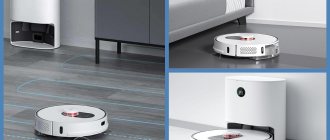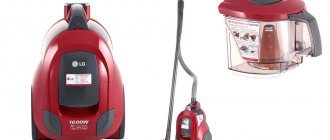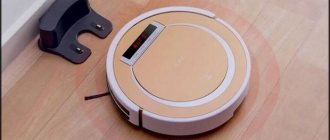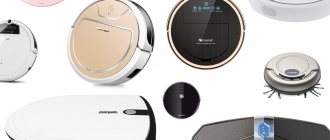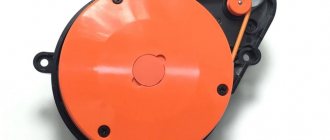Philips has been producing household appliances for decades. During this time, it has become widely known throughout the world thanks to the use of modern technologies and the quality of its products.
Philips vacuum cleaners are distinguished by their compactness, good technical characteristics and ease of use. A flexible pricing policy and a wide selection of models will allow the buyer to choose exactly the device that will suit him best.
In addition, the advantages of devices of this brand include ergonomics, good maneuverability, high suction power and the presence of special filters for air purification.
The disadvantages of Philips vacuum cleaners, compared to other brands, include the higher price of consumables and components, as well as the difficulty of purchasing them in regular household appliance stores.
We present the rating of Philips vacuum cleaners 2021. The best 7 models that were selected by our experts based on user reviews and ratings.
| Rating (2020) | Prices, ₽ | A country |
| 1. Philips FC8924 Performer Ultimate | from 19000₽ | Poland |
| 2. Philips FC9733 PowerPro Expert | from 12000₽ | China |
| 3. Philips FC9911 PowerPro Ultimate | from 12500₽ | Türkiye |
| 4. Philips FC9176 Performer | from 13500₽ | Poland |
| 5. Philips FC9573 PowerPro Active | from 9000₽ | China |
| 6. Philips FC9351 PowerPro Compact | from 5500₽ | China |
| 7. Philips FC8294 PowerGo | from 3500₽ | China |
Advantages and disadvantages
Philips FC6404 handheld equipment, according to customer reviews, has the following advantages:
- multifunctionality;
- detachable unit, which is used as a compact vacuum cleaner;
- lack of power cable;
- it is possible to add a cleaning agent to the water;
- ease of cleaning the container from dust;
- ease of storage;
- automatic fluid supply regulator.
Disadvantages of the Handstick FC6404:
- insufficient capacity of the dirt bin;
- does not remove dirt at the joints of floor coverings;
- debris remaining in the pipeline spills onto the floor;
- accelerated battery discharge when operating at high speeds;
- fragile plastic body;
- when the handle is tilted, the water tank is disconnected;
- does not remove dirt in the corners of rooms;
- there is no extension corrugated sleeve, which allows you to clean the car interior in hard-to-reach places;
- It takes up to 48 hours for moisture to evaporate from the filter.
Similar models
FC6404 competitors:
- Bosch BBH218LTD, equipped with a container with a capacity of 0.4 liters and a lithium-ion battery. The kit includes a carpet cleaning attachment with a rotating element.
- Electrolux EER77MBM, equipped with a lamp to illuminate the cleaning area; a 0.5 liter flask is located on the body. The noise level during operation is reduced to 79 dB.
How to choose a Philips vacuum cleaner?
When buying a vacuum cleaner from Philips, we recommend that you study the main criteria that a reliable and functional device must meet:
- Suction power . Choose a vacuum cleaner based on the type of surface it will work with. For carpets with long and fluffy pile, you will need at least 450 W; to remove wool and hair from carpet and furniture, models with a suction power of 400 W are required. And for quick and effective cleaning of parquet, laminate or tile, 350 W is enough.
- Dimensions . They largely affect the maneuverability of the device, and therefore the ease of use. Vacuum cleaners that are too light easily tip over, and bulky models often have to be carried manually. Therefore, a weight of 4 to 7 kg is considered the most optimal option.
- Noise level . It is difficult to classify such a device as a quiet device, however, at least at low power, suitable for daily cleaning, the noise level should not exceed 50-60 dB.
- Cord . Its length should be enough so that there is no need to use an adapter. Usually 6-7 meters is enough.
- Filter . All models from the rating below are equipped with a cleaning filter, however, if your family has people prone to allergies, then you should take a closer look at models that have an additional anti-allergenic output type filter.
- Dust collector type . This could be a bag or container. Bags are most often disposable, although they hold more dust, but their use indicates regular additional expenses. If you want to avoid them, choose models where you can use a reusable garbage bag or have a plastic container.
Appearance
Equipment FC6404/01 is a handle made of 2 asymmetrical halves, on which a removable unit with a turbine, dust collector and power source is installed. The elements of the front part of the vacuum cleaner body are made of glossy blue plastic, the rear elements are made of matte black impact-resistant material. The halves are tightened with Phillips-head screws and secured with additional latches located around the perimeter.
The control handle is equipped with a protective ring element; on the outer part there is a push-button regulator for controlling the operating modes of the Philips vacuum cleaner. Below the keys there is a 3-segment LED indicator of the battery charge level. The cleaning unit is equipped with a hinged connector that allows deviation in the horizontal and vertical planes (at an angle of 75 and 35°, respectively). At the bottom of the handle there is a removable block in which the head components of the structure are located.
The block contains a dust container flask made of transparent polycarbonate. There is a maximum dust level mark on the outside of the tank to remind the user to clean the tank. On the top surface of the unit there is a power control button and a battery status indicator, consisting of 3 segments. The block is held on the handle using clamps; a separate button is used to separate the elements.
Vacuum cleaner Philips PowerPro Aqua FC6401/01
That's what it says
Content:
- Specifications, delivery set and price
- Video review
- Appearance and function
- Testing
- conclusions
Specifications, delivery set and price
| Model name | PowerPro Aqua |
| Model code | FC6401/01 |
| Type | Cordless upright vacuum cleaner |
| Garbage collection method | Vacuum filtration + active brush |
| Main filter type | Cyclonic |
| Pre-motor filter type | Polyurethane foam (foam rubber) + fiber, 3-layer washable |
| Exhaust filter type | Polyurethane foam, not replaceable |
| Dust collector | Transparent plastic container |
| Additionally | Removable nozzle for wet cleaning, volume 0.2 l, up to 50 m² |
| Control | On the handle |
| Noise level | 83 dB (maximum 84.5 dB(A)) |
| Battery life | Up to 40 min. in normal power mode |
| Charging time | 5.5 h |
| Charging method | Cable from adapter |
| Battery | Li-ion 18V |
| Weight | No data |
| Peculiarities |
|
| Contents of delivery* |
*It is better to check the delivery set before purchasing. |
| Link to manufacturer's website | www.philips.ru |
| average price | T-12774654 |
| Retail offers | L-12774654-10 |
Video review
We invite you to watch our video review of the Philips PowerPro Aqua FC6401/01 vacuum cleaner:
Our video review of the Philips PowerPro Aqua FC6401/01 vacuum cleaner can also be viewed at filmdepo.ru
Appearance and function
The vacuum cleaner is supplied in a not very large box made of durable corrugated cardboard. Unfortunately, the box does not have a comfortable handle, only slotted ones on the sides, which complicates the transportation of the purchased vacuum cleaner. The design of the box is quite attractive and informative; the planes clearly describe the main advantages of this piece of household appliances. A minimal amount of plastic is used for packaging, and a figured “bathtub” made of papier-mâché is used to protect and distribute components - taking care of preserving the environment.
The printed materials included in the kit are a few brochures and leaflets, of which the most valuable is the user manual, printed on nondescript newsprint paper. The guide is in picture puzzles, but if you sit and think, you can figure it out.
The vacuum cleaner is delivered slightly disassembled:
The handle is inserted into the main body and secured with a screw that can be tightened, for example, with a 10 ruble coin. It is convenient to store the vacuum cleaner in an upright position, with the main unit tilting slightly forward, and the protrusion at the bottom fits into a recess on the brush body, which secures the brush hinge. As a result, the vacuum cleaner rests on the plane of the brush attachment and stands relatively stable.
The main parts of the body, brush and dust container are made of different types of plastic. Opaque parts are mostly black, transparent parts have a slight tint. The front part of the case has a mirror-smooth surface that is not resistant to scratches, which is why it quickly loses its neat appearance, and fingerprints are very noticeable on it. The back of the case is rather matte and on most of the surface has a texture similar to crocodile skin. For contrast, bright blue elements are used. For example, the inside of the handle:
Note the presence of ribbing in the place where the hand covers the handle of the vacuum cleaner. The dust collector body is made up of two parts:
This is convenient, since for frequent emptying of accumulated debris, it is enough to disconnect the lower small glass and shake it into a bucket:
Less often you have to disconnect the upper part with the cyclone and pre-motor filter:
In total, the dust collector consists of five parts, docked strictly in a certain orientation. The filter also needs to be inserted with the correct side, with the ribbon facing out:
The joints of the dust collector, the pre-motor filter and the inlet on the vacuum cleaner body have rubber seals. At least once a month, the manufacturer recommends completely disassembling the dust container, rinsing the plastic parts and filter under water, drying it, and putting it back together. The only and virtually non-detachable TriActive Turbo nozzle is equipped with a motorized brush. The purpose of the nozzle is to clean hard and carpeted floors. The nozzle is relatively low and is equipped with a pair of hinges, which allows you to climb under furniture with it with as little clearance as the body of the vacuum cleaner itself allows.
Moving the nozzle along the floor is facilitated by two wheels and two rollers with elastic plastic tires:
The width of the nozzle is 250 mm, and the working width of the brush is approximately 199 mm. Let's pay attention to the wide ends and the large distance in front to the slot with the brush, as well as the absence of air channels on the sole of the nozzle. As a result, it is unlikely that this nozzle can be used to clean areas close to walls and furniture well, and large debris will accumulate in front of the nozzle. By pressing the two latches with your fingers, you can open the compartment curtain and pull out the brush for cleaning. At one end, the steel axis of the brush rotates in a bronze sliding bearing:
At the other end, the brush is fixed in the drive coupling. Rotation from the electric motor is transmitted to the clutch using a toothed belt - a typical solution for such a case:
In the photo above you can see a metal counterweight located in front of the brush, which ensures that the brush is pressed to the floor. The function is necessary, but it increases the weight of the attachment. However, the vacuum cleaner still weighs relatively little - about 2.7 kg; by the way, the height from the floor to the top point of the handle in a vertical position is 116 cm. By unscrewing the screw and removing the fixing half-ring, the nozzle can be detached from the body of the vacuum cleaner (but it will still be connected to it by wires) in order, for example, to pull out something stuck in the joint. The seal of the joint is ensured by a plastic corrugated tube. The functionality of wet cleaning is provided by a reservoir attachment and microfiber cloths:
Water is poured into the reservoir (maybe with a drop of detergent), and a napkin is placed on its sole, held there with Velcro:
On a vacuum cleaner, the reservoir is installed behind the electric brush, where it is fixed using magnets:
To remove the tank, you don’t even have to bend over, since you just need to lightly press it to the floor with your foot from behind and pull the vacuum cleaner up. Liquid from the reservoir seeps onto the napkin through a series of tiny holes in the bar on the sole:
The bar is replaceable, so clogged holes won't be a big problem. After use, the tank should be rinsed, dried and stored dry, and it is recommended to wash it with detergent once a month. The wipes are machine washable and it is recommended to replace them with new ones every three months.
The vacuum cleaner is controlled using two buttons on the handle. The top button turns on/off, the bottom button activates high power mode. The current battery charge level is indicated by the three-segment LED indicator located below.
The vacuum cleaner is charged from the supplied power adapter,
coaxial connector from which is inserted into the mating socket on the vacuum cleaner body:
The length of the power cable is 145 cm. The delivery set includes a small bracket, which, with the inserted connector from the power supply unit, can be mounted on the wall at a height of 53 cm. The connector fixed in this way does not make it much easier to connect the vacuum cleaner to the power adapter - you still have to hold the connector and point it towards socket, but at least the cable is not lying on the floor.
To dispose of used batteries, you need to disassemble the body of the vacuum cleaner and remove them from there. We took it apart out of curiosity. The control board is relatively complex:
On its reverse side there is an 8-bit microcontroller STM8S003F3P6, which is somewhat redundant for the implemented functionality. The battery is made up of five cylindrical elements of the popular 18650 size, with slots for two more, which means that in the family of these vacuum cleaners you can expect a model with a higher battery capacity.
The elements are marked as SE US18650V3B. Google hints that these could be Sony lithium-ion cells with a capacity of 2.1 Ah and high current output, but we will not vouch for the reliability of this information. The charge and discharge of the battery is controlled by a board installed on it, which, unfortunately, does not have a cell balancing function.
The temperature of the battery pack is monitored using a thermistor placed between the cells. In general, the battery pack is designed relatively simply, so those who want to save money without much effort will be able to replace their worn-out elements themselves.
The motor that spins the fan is a simple one, a commutator motor with graphite brushes and plain bearings.
From the description we move on to practical tests.
You can see how the vacuum cleaner works and evaluate the nature of the noise in the video below:
Testing
In maximum power mode and when used for its intended purpose, the vacuum cleaner worked for 19 minutes.
(9 minutes with the wiper attachment and 10 minutes without it). For simple periodic cleaning around the house, this time will be enough. On the second run, we turned on normal power and did not use the wiper attachment. Under these conditions, the operating time was 47 minutes. We were able to remove more than 100 sq. m of flooring with rugs, commercial carpet, linoleum and laminator. We seemed to control the filling of the dust collector and tried not to overfill it, but at the end of the tests it turned out that a pile of garbage began to grow along the back wall of the dust collector cup:
This was not visible from the front. As a result, the “heavy” debris reached the upper chamber, that is, the cyclone filter actually stopped working.
Accordingly, the pre-motor filter is completely clogged:
And a little fine dust appeared even on the upper surface of this filter:
For ourselves, we came to the conclusion that you need to empty the dust collector cup when the pile of garbage is just beginning to approach the end of the pipe; you should not wait until it is filled to the Max mark. It should be noted that the garbage gathers into a relatively dense lump and does not generate much dust, while the detachable cup of the dust container is small in size; as a result, when emptying the dust container, without much effort you can almost completely avoid contact with dust. The diameter of the brush roller is relatively small, so hair and threads are wound quite tightly around it:
As indicated in the instructions, they have to be cut with scissors, and it is better to use a tool with sharp tips. You can also try using a tailor's ripper tool.
The handle in the hand does not vibrate or slip, and the hand does not feel particularly tired even after continuous operation at normal power until the battery is completely discharged. In the version with only an electric brush, the vacuum cleaner moves relatively easily across the floor. With a wet cleaning attachment, moving the vacuum cleaner across the floor requires much more effort. The moisture level of the floor is average - the wet mark is clearly visible, but there is no hint of puddles. Of course, it cannot be said that the floor is actually washed, but at a minimum it is thoroughly wiped. Obviously, a rotating brush and air flow can only work effectively on a dry floor with dry and light debris, so you need to try to move the vacuum cleaner across the floor so as not to hit a wet mark, that is, make only a forward movement with a snake, spiral, etc. .
The vacuum cleaner battery charges in about six hours, although this takes into account those few minutes during which the vacuum cleaner connected immediately after use does not charge (apparently, the battery is cooling). During charging from the network, it consumes somewhere up to 10 W peak.
We measured the noise level when placing the vacuum cleaner on the floor in the working position with a slight deviation from the vertical and with the brush pressed to the floor (commercial carpet). The sound level meter microphone was placed in a horizontal position at a height of 1.2 m from the floor and at a distance of 1 m from the vacuum cleaner motor unit and was directed at the vacuum cleaner.
| Power | Sound pressure level, dBA |
| Normal | 66,4 |
| Maximum | 73,6 |
Let's give the sound pressure level (SPL) in the range of 20-20000 Hz in 1/3 octave bands:
At maximum power level, the main contribution is made by relatively high-frequency noise from the fan motor and noise from air movement. At low power, the contribution of both of these sources is significantly reduced, and the hum from the rotation of the brush begins to become more pronounced. At high power, the vacuum cleaner for this class of devices is relatively noisy, but the nature of the noise does not cause particularly strong irritation.
We determined suction power (what it is and how we measure it is described in a separate article) by operating the vacuum cleaner at two power levels with the brush attachment disconnected. The dependence of suction power on the created vacuum is shown in the graph below:
Note that at the first point, where the vacuum is minimal, the stand valve is open, the resistance of the stand to air flow is minimal, the useful work is small, since the power is spent mainly on moving air. At the last point, the damper is closed and the suction power is zero, since there is no air movement. In the interval between these two points, the suction power reaches its maximum, since a significant vacuum is created with a large air flow, that is, useful work is performed. The maximum suction power is less than 30 W, which is formally not enough even for a vertical vacuum cleaner (but quite a lot for a portable one), however, you need to take into account the presence of an active brush, which significantly increases cleaning efficiency, especially on carpets. It is also worth making a discount on the mobility and compactness of the unit.
conclusions
The Philips PowerPro Aqua cordless vacuum cleaner is a universal device that provides dry and, if desired, wet cleaning of smooth floors and only dry cleaning in the case of carpets. The specialization turned out to be relatively narrow, so it does not completely replace a regular vacuum cleaner. However, most of the time the vacuum cleaner is used to clean the floor surface, so when using this compact vacuum cleaner, you will have to take out a large, heavy and inconvenient vacuum cleaner less often.
Advantages:
- Effective TriActive Turbo nozzle with active brush
- Additional nozzle for wet cleaning
- Nice design
- Easy-to-use dust collector
- Comfortable handle
Flaws:
- Relatively high noise level in maximum power mode
- Hair and threads are wound very tightly around the brush
- Rebus instructions
Design and equipment
The designers made the vacuum cleaner streamlined and compact. The body is made of special high-strength plastic. Metallic blue was chosen as the main color. The device handle, control buttons and bottom are black. The hose, tube and nozzles are made in black and silver.
There is a container for collecting dust on the case. It is made of transparent plastic so that the user can control the filling level of the container. Thanks to the special design with smooth edges, dust accumulates on one side of the dust collector.
The container is easily removable and can be cleaned in one motion.
Large diameter wheels have a rubberized surface. They provide the device with high maneuverability and maneuverability. Parking for the model is horizontal only. The steel tube has a telescopic design, which is convenient when preparing the device for operation. Additionally, the model is equipped with several attachments that are supplied with the device.
The Philips FC9713/01 Animal vacuum cleaner is a modification of the FC9713 device. It is well suited for cleaning the hair of dogs, cats and other pets. The package includes a SuperTurbo brush, which does an excellent job of cleaning carpets and furniture in homes where pets are kept.
The package includes:
- vacuum cleaner with hose;
- vacuum cleaner tube;
- crevice nozzle;
- 2-in-1 brush/small nozzle;
- standard TriActive nozzle;
- additional attachment - SuperTurbo brush (for model FC9713/01);
- instructions for use.
How to use
Any housewife can work with the FS 9713 vacuum cleaner. 2 large control buttons are located on the body. One of them turns the device on and off, and the other is designed to automatically rewind the cord on the body after operation. You can press the buttons with either your hand or your foot.
The manufacturer recommends replacing the output filter once a year. This part is located at the back of the vacuum cleaner behind the removable grille. The engine protection filter needs to be cleaned periodically, and its sponge part can be washed with water. The part must be completely dry before being installed in the machine.
Information on assembly, operation and maintenance of the vacuum cleaner is contained in the instructions for use, which are included in the package. There is also a list of possible malfunctions and ways to eliminate them. If the damage is significant, it is better to take the device to a Philips service center.
The FC9713 vacuum cleaner is distinguished by high-quality assembly and an excellent air filtration system thanks to the use of PowerCyclone 6 technology and a HEPA fine filter.
